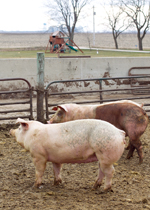![People must have renounced, it seems to me, all natural intelligence to dare to advance that animals are but animated machines.... It appears to me, besides, that [such people] can never have observed with attention the character of animals, not to have distinguished among them the different voices of need, of suffering, of joy, of pain, of love, of anger, and of all their affections. It would be very strange that they should express so well what they could not feel. -Voltaire](images/Tour/quote-growingpig.jpg) |
|
Growing Pig
Pigs can recognize their litter mates just by looking at them, even after being separated, and in the absence of other clues, like their smells or voices. There is evidence that pigs can remember up to 30 other individuals, and they are rarely seen to congregate in groups larger than 20. Because they spend most of their lives in long term groups, fighting among pigs is rare. Most disputes, usually over food, are quickly resolved by the submissive behavior of the lower ranked individual.
As they grow up, young Truebridge pigs (gilts and barrows) always live in stable groups of familiar pigs their age and size. When they are four weeks old, all the piglets of the same age are moved into a big pen together. At this age, they only weigh around 15-20 pounds and are around the same size as a domestic cat. They live together in this space until they are 6-7 months old and around 270 pounds, which is when they ready to go to market.
Just like the pens for other stages of life, growing pig pens have defined areas for eating and drinking, urinating and defecating, and sleep. When the piglets lived with their mother, they followed her lead, sleeping where she slept and dunging where she dunged. Left on their own, young pigs are likely to make a mess of their pen. So, the farmers pick up life instruction for the little pigs where their mothers left off. |
|
 |
| (before remodel) Highly Stocked Conventional Growing Pig Pen |
| |
|
|
 |
| (after remodel) Bedded Growing Pig Pen with Low Stock Density |
| |
|
|
 |
|
 |
| Pigs recognize each other even after separation. |
|
Young pigs are kept with their siblings and in stable groups. |
| |
 |
|
 |
| Their pen is laid out similarly to the farrowing pen, just larger. |
|
They stay in the same living quarters as they grow up. |
| |
|
|
 |
|
 |
| They have bowling balls and dangling chains to play with. |
|
Outdoor access provides the best source of entertainment. |
|
The farrowing pens where the piglets are born contain comfortable mats that absorb warmth from overhead heat lamps, and transfer it to their bodies. Similar lamp-warmed mats are also found in the growing pig pens, placed right next to their feeders. This serves two purposes.
The mats are cozy and familiar, and serve as a kind of security blanket for the little pigs. So, they instantly recognize these mats as the best sleeping area and end up forming a pile together, like one gigantic litter. They already know they should keep this bed clean, because that's what their mothers did.
Young pigs are used to doing all their eating and sleeping in the same place, so placing their bed right next to their feeders makes sense to them, and ensures they know where to find food. Although adult pigs show more individuality and independence, baby pigs want to do everything together. They are used to eating all at the same time, every 90−120 minutes. So, while the piglets are little, Truebridge farmers visit them every couple of hours, and hand feed them. Even though they have continual access to an especially palatable feed, this ritual reminds them that they need to eat, just like their mother used to remind them.
It also gets them familiar with humans. Soon, some of the affection they had for their mom is transferred to the familiar stockman who feeds and takes care of them. Many studies have shown that livestock recognize their farmers and even experience depression when they are replaced with someone different, so it's important not to underestimate this relationship.
The remainder of the pen has a different type of flooring, which helps identify it as a separate area, useful for goofing around and using the bathroom. Young pigs, like all young animals, are full of spirit, energy, and curiosity. Frequently, Truebridge farmers include toys in their pens, like bowling balls, hanging chains, and logs of wood, but honestly they have the most fun digging in dirt outside and rooting around in straw inside. |